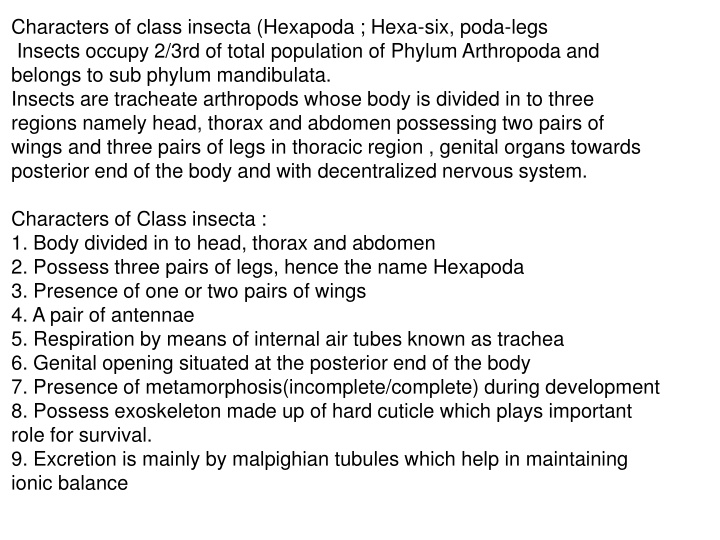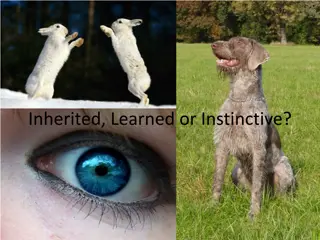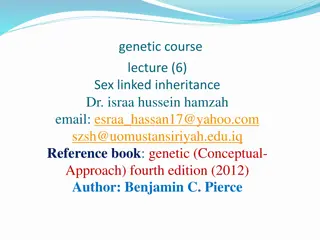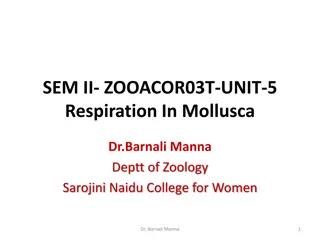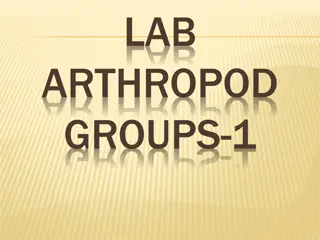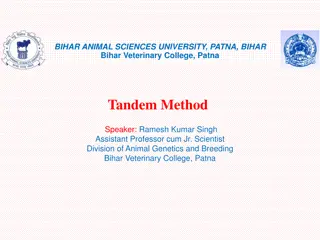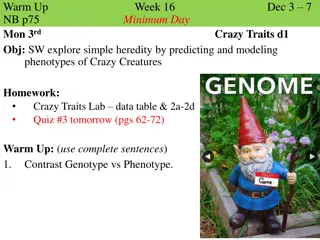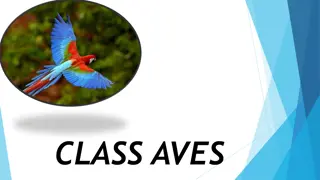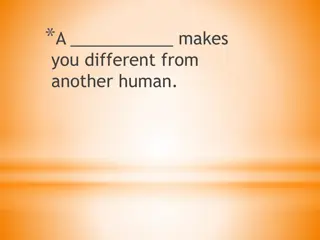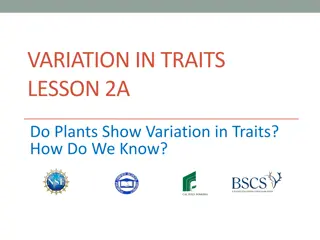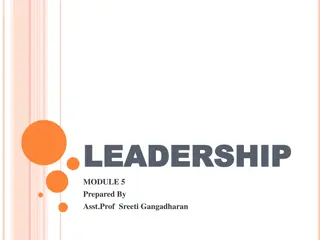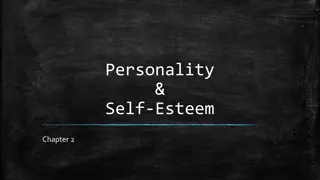Characteristics of Class Insecta: Hexapoda Traits and Integument Structure
Insects, belonging to Class Insecta, are characterized by their body division into head, thorax, and abdomen, presence of three pairs of legs, and wings. They undergo metamorphosis and rely on their exoskeleton for survival. The insect integument consists of layers like basement membrane, epidermis, and cuticle which provide protection, muscle attachment, and shape to the body. The cuticle, comprising epicuticle and procuticle, plays a crucial role in insect physiology and adaptations.
Download Presentation

Please find below an Image/Link to download the presentation.
The content on the website is provided AS IS for your information and personal use only. It may not be sold, licensed, or shared on other websites without obtaining consent from the author.If you encounter any issues during the download, it is possible that the publisher has removed the file from their server.
You are allowed to download the files provided on this website for personal or commercial use, subject to the condition that they are used lawfully. All files are the property of their respective owners.
The content on the website is provided AS IS for your information and personal use only. It may not be sold, licensed, or shared on other websites without obtaining consent from the author.
E N D
Presentation Transcript
Characters of class insecta (Hexapoda ; Hexa-six, poda-legs Insects occupy 2/3rd of total population of Phylum Arthropoda and belongs to sub phylum mandibulata. Insects are tracheate arthropods whose body is divided in to three regions namely head, thorax and abdomen possessing two pairs of wings and three pairs of legs in thoracic region , genital organs towards posterior end of the body and with decentralized nervous system. Characters of Class insecta : 1. Body divided in to head, thorax and abdomen 2. Possess three pairs of legs, hence the name Hexapoda 3. Presence of one or two pairs of wings 4. A pair of antennae 5. Respiration by means of internal air tubes known as trachea 6. Genital opening situated at the posterior end of the body 7. Presence of metamorphosis(incomplete/complete) during development 8. Possess exoskeleton made up of hard cuticle which plays important role for survival. 9. Excretion is mainly by malpighian tubules which help in maintaining ionic balance
Structure and functions of Insect Integument The body wall or integument of insects forms an exoskeletal covering of the insect body. It forms a composite structure which forms the skeleton of the insect body. It provides area for muscle attachment; protection from desiccation, physical / mechanical injuries and shape, strength to the body and its appendages. Integument consists of 3 layers (Fig. 1.) 1. Inner basement membrane 2. Middle epidermis (or) hypodermis 3. Cuticle 1. Basement membrane: It is the basal part of the body wall formed from degenerated epidermal cells and appear as non-living amorphous (shapeless) granular layer of integument.The basement membrane forms a continuous sheet beneath the epidermis, where muscles are attached and become continuous with sarcolemma of the muscles. 2. Epidermis: It is an unicellular layer formed from polygonal cells which modifies in to cuboidal or columnar during the process of moulting. These cells consists of well developed nucleus and other cytoplasmic contents. Adjacent epidermal cells are held together by means of certain cytoplasmic processes which are known as desmosomes. All the epidermal cells are glandular and secrete cuticle and the enzymes involved in production and digestion of old cuticle during moulting. The epidermal cells get differentiated in to following types based on the function they perform and may modify in to a) dermal glands producing cement layer b) trichogen cell producing hair like seta or trichome. c) moulting glands secreting moulting fluid which digests the old cuticle d) peristigmatic glands around the spiracles in case of Dipteran larvae
3. Cuticle: It is outermost thick layer of integument secreted by epidermis. It is divided in to two regions A) Upper epicuticle B) Inner procuticle A. Epicuticle: It is a thin outermost layer varying in thickness from 1-4 . Chitin is absent in epicuticle. It consists of the following 4 layers. 1. Cement layer : It is secreted by dermal glands and is composed of lipoprotein It protects the body from external damage. 2. Wax layer: It is prominent layer , 0.25 in thickness, consisting of long chain hydrocarbons, esters of fatty acids and alcohols. It serves as water proof layer preventing water loss from the body 3. Polyphenol layer: It is a non-static layer containing various types of phenols which are mainly used in the formation of the proteins It is resistant to acids and organic solvents 4. Cuticulin layer: It is an amber coloured thin layer over the surface of the epidermis which is strengthened by outer polyphenol layer. It serves the purpose of permeability and also acts as growth barrier. B. Procuticle: It is differentiated in to exo and endocuticle after sclerotization process. Exocuticle is darkly pigmented, hard and sclerotized. It offers rigidity to the cuticle and consists mainly chitin and a hard protein called sclerotin. Endocuticle is soft, light coloured and unsclerotized. It contains more chitin but lacks hard protein sclerotin
Pore canals: These are numerous fine vertical channels traversing both exo and endocuticle measuring < 1 (0.1 0.15 ) in diameter. They run perpendicularly from epicuticle through out the length of the cuticle. They are useful in transportation of cuticular material and enzymes to the outer pro and epicuticle parts.re canals: These are numerous fine vertical channels traversing both exo and endocuticle measuring < 1 (0.1 0.15 ) in diameter. They run perpendicularly from epicuticle through out the length of the cuticle. They are useful in transportation of cuticular material and enzymes to the outer pro and epicuticle parts.
Two major components of insect cuticle are i) Chitin ii) Proteins i). Chitin : It is a nitrogenous polysaccharide. (C8H13O6N)x. It accounts for 25-60 per cent of the dry weight of the cuticle. It is named by Odier in 1834. It consists of high molecular weight polymer of anhydro-N-acetyl glucosamine residues joined by -glycosidic linkages (Fig. 2.) . It is embedded with proteins in the procuticle to form glycoproteins. It is insoluble in water, alcohol, organic solvents, dilute acids and concentrated alkalies, but soluble only in concentrated mineral acids and sodium hypochlorite. Its specific gravity is 1.4 ii). Proteins: Cuticle has 3 types of proteins (a) Arthropodin: It is soft water soluble protein present in endocuticle. The conversion of arthopodin in to sclerotin is known as sclerotization or tanning. (b) Sclerotin: It is also called tanned protein which is amber coloured and present only in exocuticle. (c) Resilin : It is a rubber like elastic protein which is colourless and present in joints such as wing hinge ligaments, leg joints, clypeolabral joints or suture and tergosternal joints.
A. Cuticular Out growths: They are divided into cuticular appendages and cuticular processes depending on the presence or absence of membranous articulations. I. Cuticular appendages: These are the outgrowths of the cuticle / integument connected with it by means of a membranous joint . They arise from modified epidermal cells. These are classified in to setae and spurs. (1) Seta/ Macrotrichia: Commonly known as hairs and arise from a cup like alveolus or pit. Setae are hollow structures developed as extension of exocuticle and are produced by a single enlarged hypodermal cell called trichogen cell. Articular membrane is usually produced by a second hypodermal cell called tormogen cell (Fig. 3). Setae have role of taxonomic importance and vary with species to species. Study of arrangement of setae is known as chaetotaxy . Different kinds of setae are as follows (a) Clothing hairs: These are hair like structures that cover the entire body, legs and wings. Eg: honey bee (b) Scales: These are varyingly pigmented plate like structures covering the body as well as wings of adult moths and butterflies (Fig. 3). (c) Glandular setae : Setae that functions as outlet for the secretion of hypodermal glands. If they are stout they are called glandular bristles as in case of certain larvae of Lepidoptera (Fig. 3). (d) Sensory setae : These are the setae or trichomes provided with sensory receptors or sensory nerve cells and respond to the external stimuli. These are present on antennae, legs and mouth parts.
(2) Spurs : Occur on the legs of many insects and differ from setae in being multicellular in origin. II. Cuticular processes: They have no membranous articulation. They are of two types (1). Microtrichia / fixed hairs / aculei: These are minute hair like structures found on wings of Mecoptera and certain Diptera. (2). Spines : Outgrowths of the cuticle which are more or less thorn like in form. B. Culticular invagination: The body wall or cuticle of the body wall invaginate internally and grow in to definite structures which are of two types. Apodemes Hollow cuticular invaginations which provide area for muscle attachment Apophyses Solid invaginations of the cuticle which gives mechanical support to various organs by forming distinct skeletal structures.
